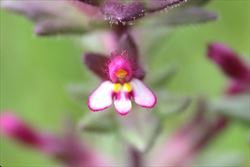Click on images to enlarge

infestation (Photo: Rob and Fiona Richardson)

habit (Photo: Rob and Fiona Richardson)

habit (Photo: Rob and Fiona Richardson)

hairy stems and leaves (Photo: Rob and Fiona Richardson)

flower buds (Photo: Rob and Fiona Richardson)

flowers (Photo: Rob and Fiona Richardson)

close-up of flowers and sticky hairs on leaf-like floral bracts (Photo: Greg Jordan)

close-up of flower (Photo: Rob and Fiona Richardson)
Scientific Name
Parentucellia latifolia (L.) Caruel
Synonyms
Bartschia latifolia (L.) Sibth. & Sm.Bartsia latifolia (L.) Sibth. & Sm.Euphrasia latifolia L.
Family
Scrophulariaceae
Common Names
broadleaf glandweed, common bartsia, red bartsia, red tarweed, southern red bartsia
Origin
Native to the Mediterranean region.
Naturalised Distribution
Widely naturalised is southern Australia (i.e. in eastern and southern New South Wales, the ACT, Victoria, Tasmania, many parts of South Australia and the southern and western parts of Western Australia).
Also naturalised overseas in south-western USA (i.e. California).
Notes
Red bartsia (Parentucellia latifolia) is regarded as an environmental weed in Victoria and Western Australia.
This species is regarded as a potential threat to one or more vegetation formations in Victoria, and appears on some local and regional environmental weed lists in this state (e.g. in the Goulburn Broken Catchment and the Mornington Peninsula Shire). It has also been recorded in several conservation areas in Victoria (e.g. Brisbane Ranges National Park, Cobra Killuc Wildlife Reserve, Boonderoo Nature Conservation Reserve and Dookie Bushland Reserve) and is one of several closely-related weed species that are thought to be competing with the endangered native rough eyebright (Euphrasia scabra).
In Western Australia, red bartsia (Parentucellia latifolia) is widespread in wetlands, open woodlands and granite outcrop vegetation throughout the south-western parts of the state. It has been recorded in conservation areas (e.g. Mooradung Nature Reserve) and was recently ranked as a moderately high priority species in the Environmental Weed Strategy for Western Australia.
Though not widely seen as an environmental weed in other parts of temperate Australia, it has often been recorded in natural areas in other states. For example, it commonly grows in open woodlands, disturbed moist sites and marshy localities in southern and central New South Wales and south-eastern South Australia. It has also been recorded in conservation areas in South Australia (e.g. Coorong National Park, Montacute Conservation Park, Belair National Park, Sturt Gorge Recreation Park, Kaiserstuhl Native Forest Reserve, Kaiserstuhl Conservation Park and Angove Conservation) and Tasmania (e.g. Trevallyn Nature Recreation Area).

